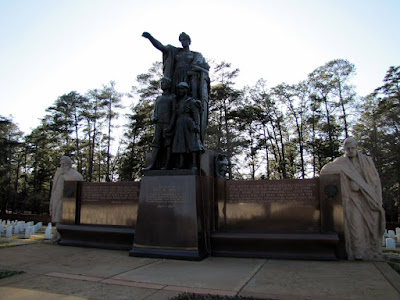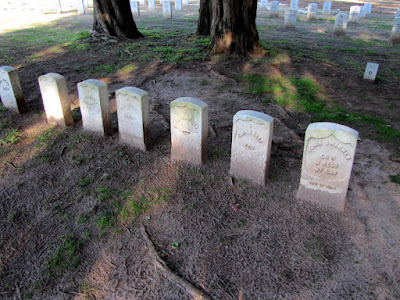 |
| From Andersonville |
The place that I have gone in Georgia that has had the most profound impact on me is my visit to Andersonville earlier this year. So much so, that I have decided to discuss it in three parts. In part one, I talked about the Andersonville Civil War Prison itself and the Prisoner of War Museum, and I’ll admit that I pontificated a little bit. In part two, I will try to avoid that as I discuss the Andersonville National Cemetery.

If you wish to view this place as a good place to take a walk, the additional 1.2 miles here added to the prison site takes the total distance travelled up to 2.7 miles. And if walking isn’t an option, you can travel most of the site by car, though you will have to get out if you are looking for an individual gravesite. And, I must add, even though I walked it, I don’t think that is the way it should be taken. It should be something more. It is a place of honor: an honor of the solemn trust and memory of those who fought and died for our country.

The first part of the cemetery contains the 13,000+ graves of the men who died during interment here during the Civil War, most from the armies of the Union States. The grave marked number 1 belongs to Adam Swarner of New York and unfortunately the place closed before I could find the last grave. There are monuments erected by every state that had soldier die in Andersonville throughout these graves. The graves line up in perfect lines on short white marble throughout the middle Georgia landscape. 921 of these graves are marked unknown.

Notable among the graves are six gravestones set apart from all the others, not in a place of honor, but in a place of shame. They were the six known as the “Raiders.” They were executed at the Prison for crimes within the prison. With no officers held at Andersonville, the swelling numbers of enlisted men fell into anarchy, and the guards lacked both the manpower and probably the will to do anything about it. The group numbered depending on reports somewhere between 50 and 500 (with best estimates placing it between 75 and 150) and they would steal, intimidate, beat, and sometimes murder their fellow inmates in order to secure what valuables the other prisoners had. After a prisoner named Dowd was beaten and had his money and watch taken, he complained to the guards, and this caught the attention of Captain Henry Wirz, the head of the camp, who decreed that all rations would be cut off until the Raiders were turned in. Building on less well organized protection groups built from squadrons housed together; a rival gang, or rather, police force was formed called the Regulators. They brought the Raiders to justice, held a trial within the prison of their peers, and the six chieftains were court-martialed and sentenced to be hung. The remaining Raiders were forced to run a gauntlet of other prisoners as their penance being beaten by those they formerly terrorized. The six that were hanged were: John Sarsfield, William Collins, Charles Curtis, Patrick Delaney, A. Munn, and WR Rickson (AKA Teri Sullivan), though there is some controversy as to whether these were their real names.

In addition to the prisoners who died here, the site is a National Cemetery and more of our fallen soldiers have been buried here since the Civil War, pushing the total to above 18,000, representing virtually every war since. Two of whom were Congressional Medal Of Honor recipients. James Wiley fought in the Civil War and died during internment at Andersonville and he is credited with the capture of a Georgia Regiments flag at Gettysburg. The other is actually an “in memory of” headstone, as his body has never been recovered, and that belongs to Luther Story, who was awarded for taking out a truck full of enemy combatants singlehandedly near Agok during the Korean War.

As I said before, this is a solemn place and the feeling of sadness is palpable. Some wish to attribute this to some sort of paranormal activity, and I like nothing better than a good ghost story, even if it is just a story. But it just doesn’t seem right to do that here (the stories are easy to Google if you need them). Andersonville National Cemetery deserves more respect than that. This place coupled with the POW museum and the Prison, is a must see for all Americans who are able to reflect on our past, our fallen brothers, and the hopes of our future.

Trail Essentials
Approximate Time: 1-1.5 hours
Approximate Distance: 1.2 miles
Trail Surface: paved and grass
Features: Grave markers and statues
Overall Rating: A
Scenic Quality: A
Athleticism: C
Solitude: A
Value: A
Parking: Free
Hours of Operation: 8am – 5pm
Facilities: At the POW Center
Maps: Not needed
County: Macon
No comments:
Post a Comment